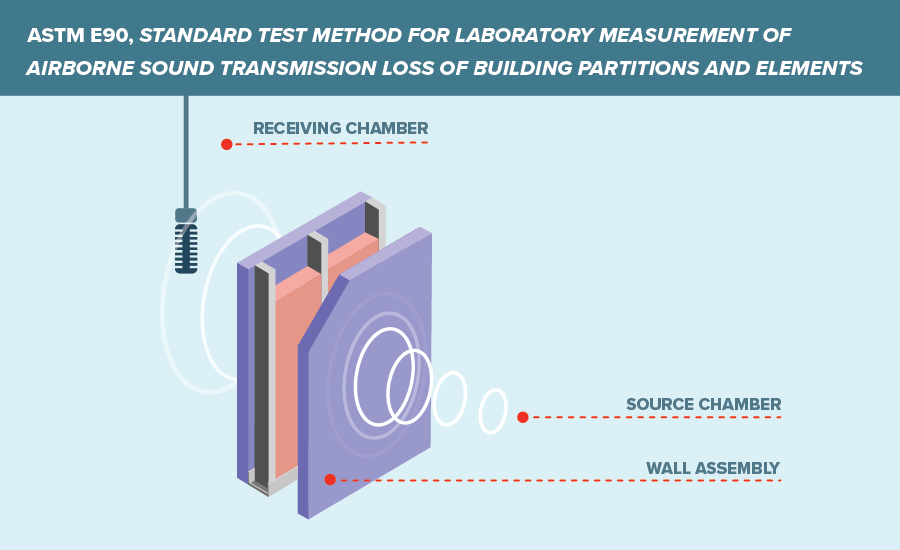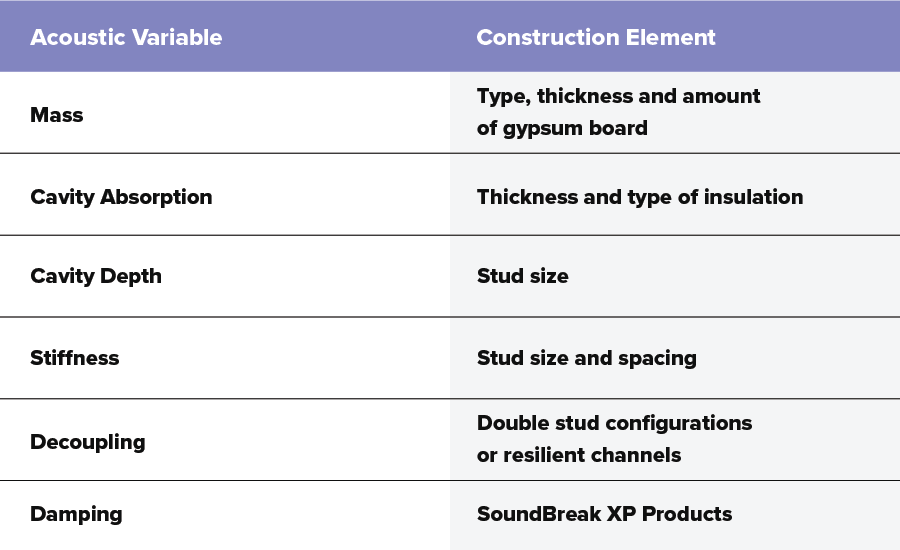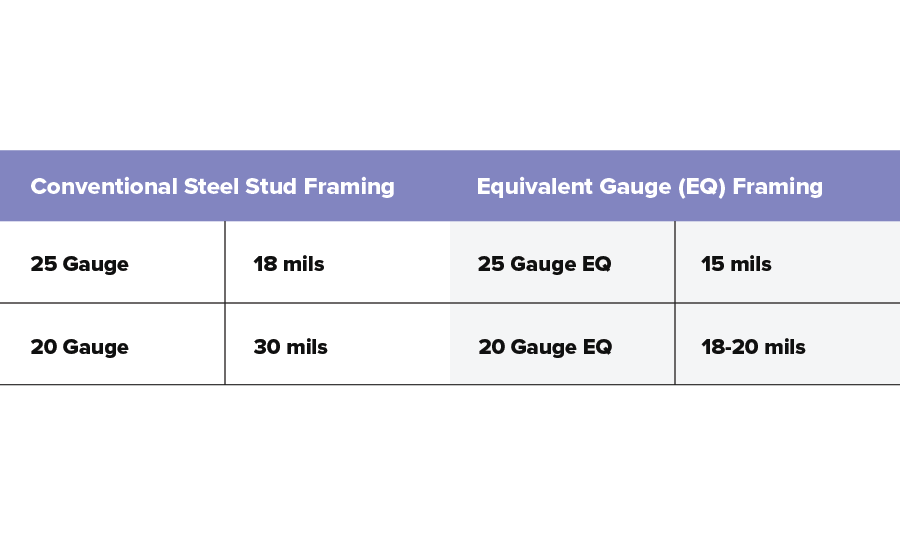Demand for silent spaces continues to rise, whether to reduce noise between apartments, maintain the privacy of conference room discussions or keep exam room conversations compliant with healthcare privacy laws.
Selecting and constructing the right acoustical wall design that balances code, material and client requirements can be challenging. If you alter just one part of the assembly, it can change the Sound Transmission Class rating, but not every element in the assembly carries the same weight with regard to the STC rating.
This article will explore the six construction elements that affect STC ratings of wall assemblies.
What is a Sound Transmission Class?
STC is a number rating that represents how well a wall assembly abates airborne sound traveling from one room to another. Keep in mind that the ratings apply only to the entire wall assembly and not its individual components. For example, SoundBreak® XP® gypsum board doesn’t have an STC rating, but the wall assembly it is part of does.
Assemblies with higher STC values are more effective at reducing sound transmission. While the International Building Code designates an STC rating of 50 as the minimum allowable design rating for unit demising walls in multifamily construction, sometimes a higher rating is desired.
How does sound travel?
Sound is energy transmitted by vibration through a medium. The denser the medium, the faster sound will travel. Sound travels through steel at roughly 6,000 yards per second compared to roughly 360 yards per second through air. Or, consider the sound of a pencil tapping on a desk: The sound seems much louder if you lay your ear on the desk, because the sound waves reaching your ear are traveling through the desk rather than through the air. In a wall assembly, the sound will travel faster through denser materials, such as the framing, than it will through insulation or air spaces.
At a molecular level, when someone or something makes a sound, it energizes the air molecules, causing each one to knock against the next molecule, which knocks against the next molecule, and so on. This chain reaction is a sound wave that we perceive as sound when it vibrates our eardrums. The frequency of a sound is the number of vibrations per second, measured in hertz. One vibration per second equals 1 Hz.
The human ear can hear frequencies between 20 Hz and 20,000 Hz, though the ability to hear higher frequencies degrades with age. People are most sensitive to sound in the 100- to 5,000-Hz range. (The lowest and highest notes on a piano are 27.5 and 4,186 Hz.)
How are acoustical assemblies tested?
STC values are calculated from data collected using ASTM E90, Standard Test Method for Laboratory Measurement of Airborne Sound Transmission Loss of Building Partitions and Elements.
- The wall assembly is mounted in a frame between two rooms: a source chamber and a receiving chamber.
- The test measures 16 frequencies between 125 Hz and 4,000 Hz, the range to which human ears are sensitive.
- Sound signals that have a continuous spectrum within each test frequency band are played in the source chamber.
- Microphones in the receiving chamber measure the decibel levels of the sound signals at each frequency. The difference in the decibel levels on each side of the wall is the transmission loss.
- The transmission loss values are plotted on a graph to form a curve that is positioned in relation to a standard reference curve. The STC is the value of the reference curve at 500 Hz.

How can you modify a wall assembly to change its STC value?
Wall assemblies consist of wood or metal studs, insulation, fasteners (screws or nails) and gypsum board. There are six acoustical design variables, and each one can be used to reduce sound transfer by changing elements of the assembly. In this section, we will explore how each construction element affects different acoustical variables and how to make adjustments that accommodate design constraints such as limiting wall heights or allowable deflection.

Mass
Adding layers of gypsum board to one or both sides of a wall assembly increases the STC by adding mass. The examples below (figures 1 and 3 in National Gypsum Company’s The SoundBook®) show that adding mass is a cost-efficient method for achieving a moderate increase in STC, but the drawback is that it takes up additional floor space.

Cavity Absorption
Providing insulation in the wall cavity can significantly boost a wall assembly’s STC rating because it is a sound-absorbing material. Glass fiber or mineral wool insulation performs the best. Spray foam insulation provides little value in sound reduction because it becomes very stiff when it hardens — creating an ideal material through which sound can easily travel.

The examples below (figures 6 and 7 in The SoundBook) compare an uninsulated wall with an insulated wall, which boosts the STC rating 8 points.
Cavity Depth
Deeper studs create space to add more insulation, which can boost the assembly’s STC rating.
The two steel-frame wall assemblies below (figures 9 and 25 in The SoundBook) show a gain of 4 points by going from 3-5/8" studs with 3-1/2"-thick insulation to 6" studs with 6"-thick insulation.

Stiffness
Controlling stiffness is often the most challenging aspect of selecting an acoustical wall assembly, but it can affect the STC rating in a big way. Less stiff wall assemblies are better at mitigating sound transmission, and this can be achieved in multiple ways:
- Change the stud spacing: 24" o.c. framing will typically provide a higher STC rating than 16" o.c. framing.
- Choose metal studs: Metal studs are inherently more flexible than wood studs.
- Use thinner gauge studs: A thinner stud gauge provides better STC performance than a thicker stud gauge.
These approaches can be used to achieve the desired STC but must also comply with other factors such as height limitations and deflection limits from the stud manufacturer.
Be aware of the growing popularity of EQ studs. EQ studs use thinner steel than their equivalent standard-gauge counterparts but have the same or higher flexural strength. Conventional 25-gauge studs are no longer the standard for non-load-bearing partitions, and 20-gauge EQ studs are often substituted in their place. Despite having the same 18 mil thickness, the EQ stud is a little stiffer and could affect the STC.

The example below (figures 9 and 8 in The SoundBook) shows the decrease in stiffness between a standard 20-gauge stud on the left and a 20-gauge EQ stud on the right, resulting in a gain of 6 STC rating points.

Decoupling
Because sound moves more easily through solids than air, decoupling the two sides of the wall will help to slow down sound waves. Examples of decoupling methods include:
- Chase walls have two rows of studs that separate the wall assembly with a continuous air space. Additionally, chase walls can have two rows of insulation for additional sound absorption. While very effective at mitigating sound transmission, chase walls take up significantly more floor space. In the example below (figures 8 and 137 in The SoundBook), see how the chase wall provides a 14-point increase in STC rating from a single-stud wall assembly.

- Resilient channels are light-gauge horizontal framing members used to separate the gypsum board from the studs. Resilient channels reduce the paths of solid material through which sound can travel to the only points where the channels are connected to the studs. They come in two shapes: RC-1 has one leg that attaches to the studs, while the RC-2 has two legs. In the comparison below, the resilient channel boosts the STC rating by 5 points.

- Resilient isolation clips combined with rigid furring channels perform similarly to resilient channels. They are more costly, but they are more effective at improving the STC rating by further isolating the sound energy at the stud intersections. The example below (figures 16 and 20 in The SoundBook) compares the use of a resilient channel on the left and resilient isolation clips on the right.

Constrained Layer Damping
Constrained layer damping dissipates the vibrational energy of sound waves by converting the sound energy to negligible heat. The Gold Bond® SoundBreak® XP® family of gypsum board products provides constrained layer damping with viscoelastic polymer sandwiched in between two layers of gypsum board that dissipates sound waves. And because the viscoelastic layer is added during the manufacturing process — and not on the worksite — it’s evenly applied for consistent sound damping throughout the board. Sound-damping gypsum board handles, installs and finishes just like conventional gypsum board.
Note that adding SoundBreak or resilient channels will have negligible effects on chase walls.
The example below (figures 81 and 84 in The SoundBook) shows how adding just one layer of SoundBreak XP boosts the STC rating by 11 points.

Download the SoundBreak XP Sound Solutions Brochure today to see how the SoundBreak family of drywall products can help you build silence where it’s needed.




.jpg)
